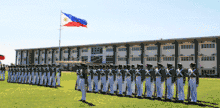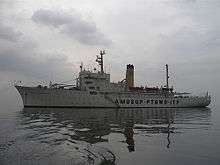Maritime Academy of Asia and the Pacific
The Maritime Academy of Asia and the Pacific (MAAP) is a non-stock, non-profit maritime higher educational institution which is owned, developed and operated by the Associated Marine Officers’ and Seamen’s Union of the Philippines (AMOSUP). Its president, Capt. Gregorio S. Oca, alumnus of Philippine Nautical School (presently Philippine Merchant Marine Academy) heads the Academy’s board of governors, a group comprised by some of the organizations in the international maritime industry: the Filipino Association of Maritime Employers (FAME), the International Transport Workers’ Federation (ITF), the All Japan Seamen’s Union, the Norwegian Seafarers’ Union (NSU), the International Maritime Employers Committee Limited (IMEC), the Danish Shipowners Association, the Norwegian Shipowners Association (NSA), Japanese Shipowners Association (JSA), and the International Mariners Management Association of Japan (IMMAJ). With their technical and financial support, the first MAAP campus opened in 1999.
MAAP-Kamaya Point (Tagged Name) | |
 | |
| Motto | Virtus, Fides et Disiplina |
|---|---|
| Type | Private Institution |
| Established | January 14, 1998 Cradle of Destiny (Academy Hymn) |
| Founder | Capt. Gregorio S. Oca PNS graduate(Presently PMMA) |
| President | VADM Eduardo Ma. R. Santos, AFP (Ret.) |
| Location | , , Philippines 2105 |
| Campus | 103 hectares *MAAP-East (Old Campus) *MAAP-West (New AJSU-IMMAJ Campus) |
| Colours | |
| Affiliations | AMOSUP, PTGWO, ITF, FAME, JSU, IMMAJ, NSU, IMEC, NSA, JSA, Philippine Navy |
| Website | www.maap.edu.ph |
The All-Japan Seamen’s Union (JSU) and the International Mariners Management Association of Japan (IMMAJ) has partnered with MAAP to build a second facility within the Academy grounds, the JSU-IMAAJ Campus.
History

The Maritime Academy of Asia and the Pacific (MAAP) was established on January 14, 1998 at Kamaya Point, Alas-asin, Mariveles, Bataan, in an 18-hectare (44-acre) land. It was founded by Capt. Gregorio S. Oca, an alumnus of Philippine Nautical School (presently Philippine Merchant Marine Academy), chairman of the Associated Marine Officers and Seamen's Union of the Philippines (AMOSUP). Its inauguration on November 6, 1999 was attended by Philippine President Joseph Ejercito Estrada.
It is run by a governing board from the AMOSUP, the private sectors, the Danish Shipowners Association, the Norwegian Shipowners Association, the Japanese Shipowners Association, the All Japan Seamens' Union, the International Worker's Transport Federation, the International Maritime Employees Committee, and the Filipino Association of Mariner's Employment.

In 2009, the academy expanded its campus from its initial 18-hectare (44-acre) land area to a 103 hectares (250 acres). Two Japanese seafarer organizations, the All Japan Seamen's Union (JSU) and the International Mariners Management Association of Japan (IMMAJ), contributed to the construction of the new campus and was involved from then on with its operation. Hence, the additions to its initials "AJSU-IMMAJ Campus".
Facilities

The two campuses are located on Kamaya Point Road, on the southern slope of Mount Mariveles near the shore of Manila Bay facing Corregidor Island. Each has three main buildings: an academic building with classrooms, simulators, laboratories and a library; a dormitory with a capacity of 1,000; and a dining hall. Two Scandinavian-made simulators are housed in the academic buildings. The MAAP training dock is located at the end of Kamaya Point Road on the shore of the North Channel entrance of Manila Bay.

Summary of Facilities:
- Navigation Simulator Complex with 360° field of vision on a platform each linked to Full Mission Engine Simulator
- Chart/ECDIS Exercise Room
- GMDSS Laboratory
- Liquid Cargo Handling Simulator
- Computer-based Propulsion Plant
- Electrotech Laboratory
- Machine Shop
- Physics Laboratory
- Chemistry Laboratory
- Microwave VSAT System and 3 servers for Telecommunications & Internet Access
- Computer Laboratory
- Refrigeration/Air-conditioning Laboratory
- Japanese Compact Ship Handling Simulator
- Pneumatic/Hydraulic Laboratory
- Electromechanical Systems & Automation Laboratory
- Liquid Natural Gas Simulator
- Fire Fighting Center
- Vessel Training Center
- Enclosed Lifeboat on Free Fall Davit
- Chemical/Product Tanker Simulator
- Language Laboratory
- Modern Library with over 8,000 titles
- Helicopter Underwater Escape Trainer
- Demonstration Kitchen for culinary courses

Academic degrees
The academy awards the following degrees:
- Bachelor of Science in Marine Transportation (BSMT)
- Bachelor of Science in Marine Engineering (BSMarE)
- Bachelor of Science in Marine Transportation and Engineering (BSMTE)
The academy also offers subsidiary and supplementary courses such as Cook's Course, Bridging Program, Trainings on Fire Fighting and Medical First-Aid.
Its ROTC program is supervised by officers from the Philippine Navy.
Its first graduates for the dual course (BSMTE) came from the Class of Valchirion (2009). Graduates of the said course are sponsored by Maersk Filipinas.
Training Ship

The TS Kapitan Felix Oca was launched by NKK Corporation as MS Seiun Maru in July 1968 in Yokohama, Japan. It was owned by first owned by Inter Pacific Lines Co.,Ltd. of Japan and utilized as a training ship.
In 1997, AMOSUP (Associated Marine Officers and Seamen's Union of the Philippines) acquired the training ship M.V. Seiun Maru from the Ministry of Transport of Japan. It was delivered in Manila on November 19, 1997 and placed under the Philippine flag with the vessel name “T/S Kapitan Felix Oca“.
It was designated as a Philippine Navy Affiliated Reserve Unit (PNARU) on September 24, 1999.
The TSKFO is equipped with a training bridge with actual navigation instruments, engine lecture room, engine exercise room and automated engine control room.
| |
|---|---|
| Owner | Associated Marine Officers and Seamen’s Union of the Philippines (AMOSUP) |
| Ship Manager | Maritime Academy of Asia and the Pacific-Kamaya Point (MAAP-Kamaya Point) |
| No. of Crew | 28 |
| Total Capacity | 247 |
| No. of Cadets | 180 |
| Ship’s Earth Station ID No. | 1701575 |
| Port of Registry | Manila |
| Registration No. | 105069 |
| IMO No. | 6903876 |
| Call Sign | DYHH |
|
|
||
|---|---|---|---|
| Length | 114.55 m | Engine | Hitachi2BF-110 750 VT-B&W Diesel |
| Breadth | 26 m | Boiler | Water Tube 1 unit single drum |
| Depth | 8 m | Service Speed | 16.72 knots |
| Net Tonnage | 1508 tons | ||
| Gross Tonnage | 5028 tons | ||
| Deadweight | 5781.20 tons |
See also
References
External links
| Wikimedia Commons has media related to Maritime Academy of Asia and the Pacific. |